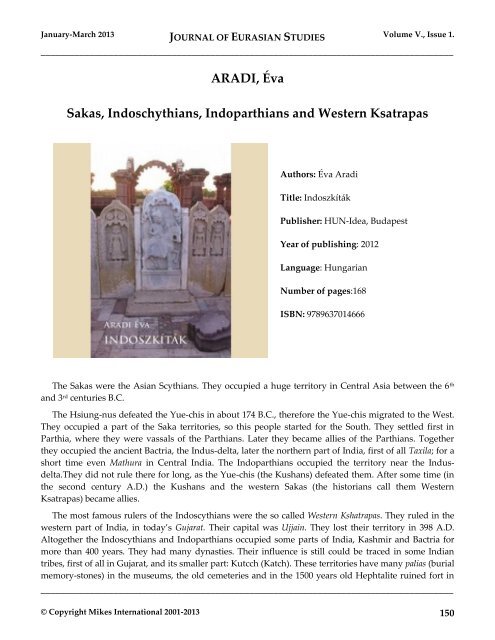JOURNAL OF EURASIAN STUDIES Journal of the Gábor Bálint de ...
JOURNAL OF EURASIAN STUDIES Journal of the Gábor Bálint de ...
JOURNAL OF EURASIAN STUDIES Journal of the Gábor Bálint de ...
Create successful ePaper yourself
Turn your PDF publications into a flip-book with our unique Google optimized e-Paper software.
January-March 2013 <strong>JOURNAL</strong> <strong>OF</strong> <strong>EURASIAN</strong> <strong>STUDIES</strong> Volume V., Issue 1.<br />
_____________________________________________________________________________________<br />
ARADI, Éva<br />
Sakas, Indoschythians, Indoparthians and Western Ksatrapas<br />
Authors: Éva Aradi<br />
Title: Indoszkíták<br />
Publisher: HUN-I<strong>de</strong>a, Budapest<br />
Year <strong>of</strong> publishing: 2012<br />
Language: Hungarian<br />
Number <strong>of</strong> pages:168<br />
ISBN: 9789637014666<br />
The Sakas were <strong>the</strong> Asian Scythians. They occupied a huge territory in Central Asia between <strong>the</strong> 6 th<br />
and 3 rd centuries B.C.<br />
The Hsiung-nus <strong>de</strong>feated <strong>the</strong> Yue-chis in about 174 B.C., <strong>the</strong>refore <strong>the</strong> Yue-chis migrated to <strong>the</strong> West.<br />
They occupied a part <strong>of</strong> <strong>the</strong> Saka territories, so this people started for <strong>the</strong> South. They settled first in<br />
Parthia, where <strong>the</strong>y were vassals <strong>of</strong> <strong>the</strong> Parthians. Later <strong>the</strong>y became allies <strong>of</strong> <strong>the</strong> Parthians. Toge<strong>the</strong>r<br />
<strong>the</strong>y occupied <strong>the</strong> ancient Bactria, <strong>the</strong> Indus-<strong>de</strong>lta, later <strong>the</strong> nor<strong>the</strong>rn part <strong>of</strong> India, first <strong>of</strong> all Taxila; for a<br />
short time even Mathura in Central India. The Indoparthians occupied <strong>the</strong> territory near <strong>the</strong> Indus<strong>de</strong>lta.They<br />
did not rule <strong>the</strong>re for long, as <strong>the</strong> Yue-chis (<strong>the</strong> Kushans) <strong>de</strong>feated <strong>the</strong>m. After some time (in<br />
<strong>the</strong> second century A.D.) <strong>the</strong> Kushans and <strong>the</strong> western Sakas (<strong>the</strong> historians call <strong>the</strong>m Western<br />
Ksatrapas) became allies.<br />
The most famous rulers <strong>of</strong> <strong>the</strong> Indoscythians were <strong>the</strong> so called Western Kshatrapas. They ruled in <strong>the</strong><br />
western part <strong>of</strong> India, in today’s Gujarat. Their capital was Ujjain. They lost <strong>the</strong>ir territory in 398 A.D.<br />
Altoge<strong>the</strong>r <strong>the</strong> Indoscythians and Indoparthians occupied some parts <strong>of</strong> India, Kashmir and Bactria for<br />
more than 400 years. They had many dynasties. Their influence is still could be traced in some Indian<br />
tribes, first <strong>of</strong> all in Gujarat, and its smaller part: Kutcch (Katch). These territories have many palias (burial<br />
memory-stones) in <strong>the</strong> museums, <strong>the</strong> old cemeteries and in <strong>the</strong> 1500 years old Hephtalite ruined fort in<br />
_____________________________________________________________________________________<br />
© Copyright Mikes International 2001-2013 150

















